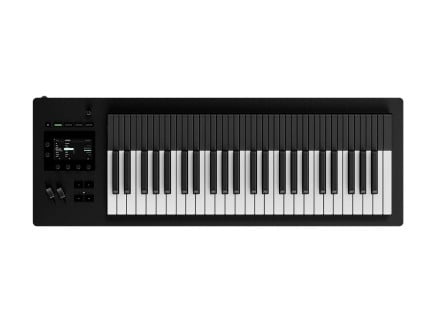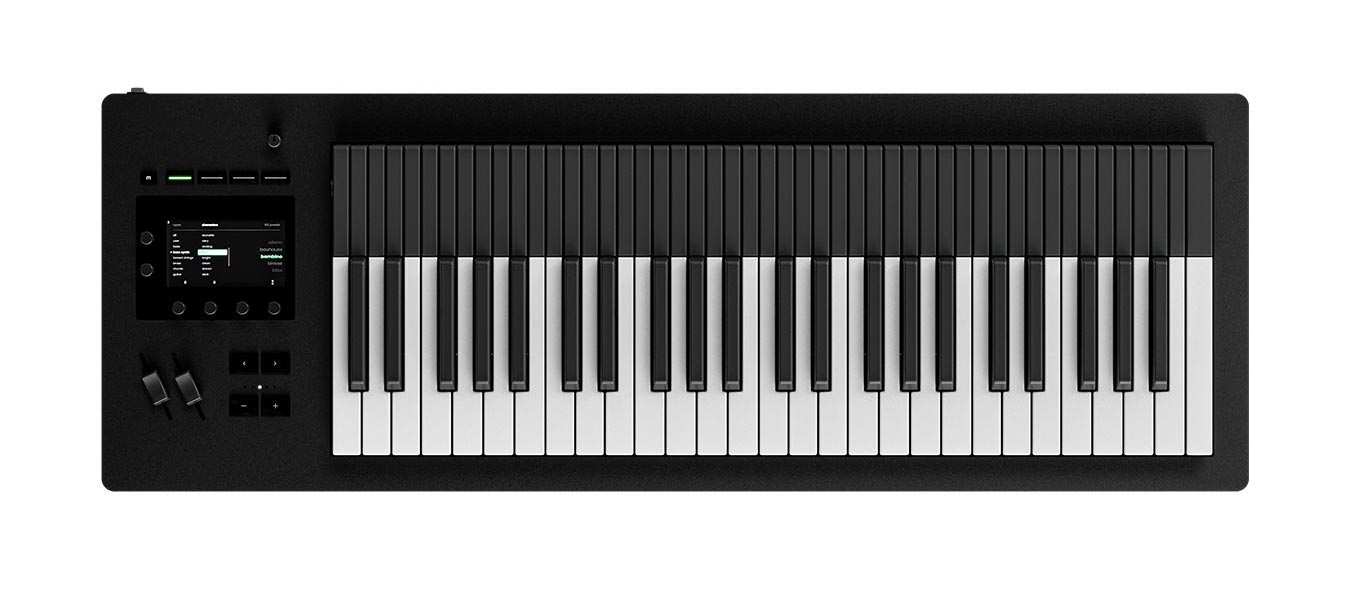The wait is over MPE aficionados—Expressive E's highly-anticipated Osmose keyboard synthesizer / MPE MIDI controller is finally in production, and the first batch of instruments is shipping out to early direct preorders. Now that Expressive E is opening up Osmose orders to dealers, we at Perfect Circuit are beyond excited to be carrying this one-of-a-kind feat of musical engineering.
If you haven't been following along with the development updates, Osmose is a keyboard synthesizer and MIDI controller, but with a unique, expressive three-dimensional keyboard that allows you to play in totally new ways. Each key can generate pitch bends, separate tap and pressure contrours, and other gestures that were previously unheard of from a keyboard instrument. And these may all be applied to the internal sound engine, or routed out to your favorite MPE-capable software or hardware synths.
But summarizing Osmose so briefly is a huge disservice to its capabilities. Much like an acoustic instrument, there's so much to be said in the nuanced artistic expression of a musician, and Osmose does away with a number of the barriers found in playing electronic instruments. Keep reading for some more insight into why we're so enthusiastic about Osmose.
Why MPE?
A full overview of MPE is beyond the scope of this product spotlight for Osmose, but I'd recommend checking out our previous article What is MPE? if you're not familiar with this side of the MIDI specification. What we will do, though, is summarize the essential bits of MPE as they are applied to the design of Osmose.
MPE, short for MIDI Polyphonic Expression, is a subset of MIDI capabilities that empowers electronic musicians with new ways of interacting with synthesizers and instruments. As such, we're seeing continual development of new controllers that totally reframe the interactive relationship between human and musical machine. Many of these devices bear no immediate resemblance to pre-existing instruments and embrace the dream of pioneering new frontiers in electronic music.
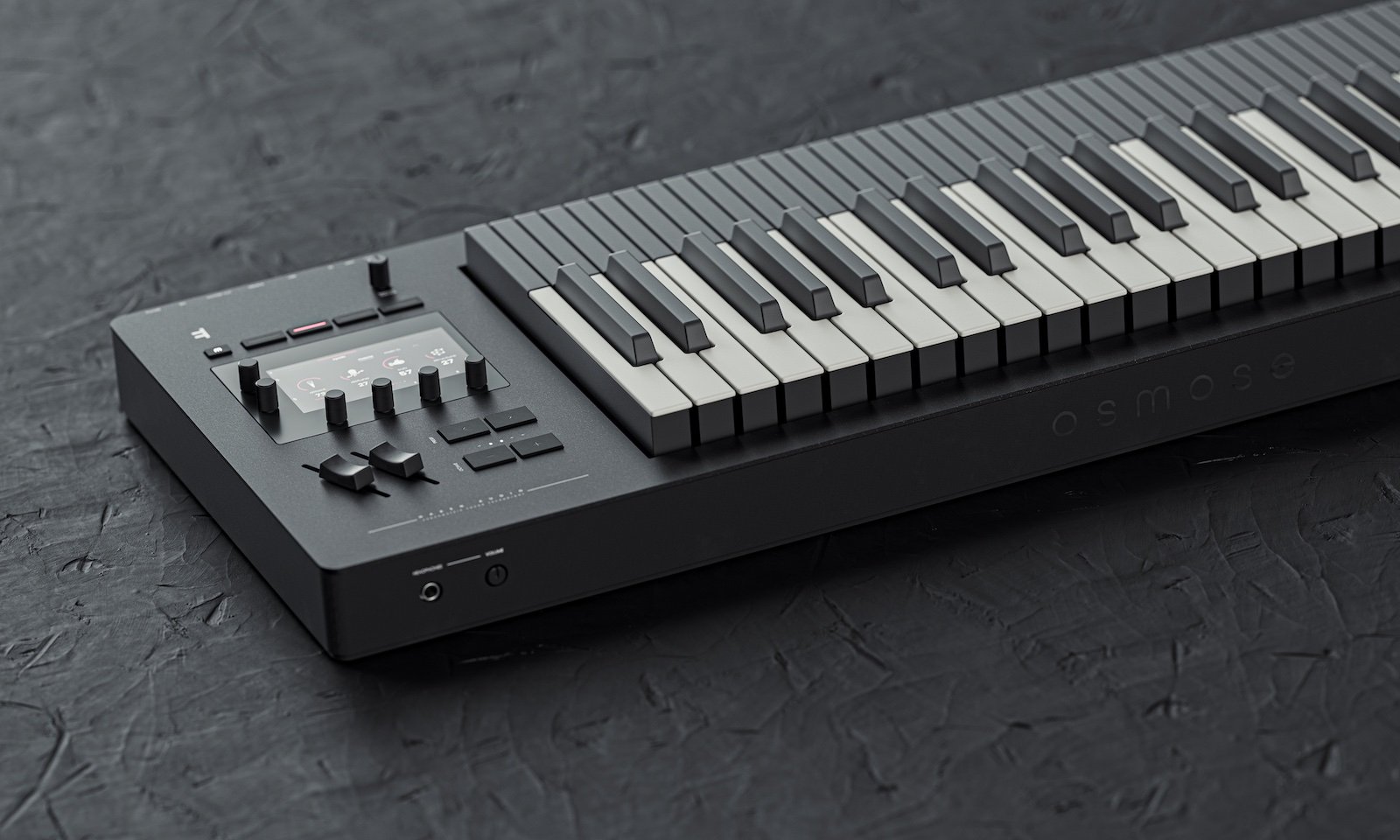
That said, designing an MPE controller with more traditional roots can make for a much more approachable playing experience—and few instruments make more sense as a starting point than a piano. Basic interaction with a piano is incredibly easy, and there are plenty of situations in which the familiar layout of a piano keyboard can be helpful in framing your musical ideas. Osmose is certainly not the first MPE controller to look sort of like a piano, but it is certainly the most explicitly obvious take on one—it actually has the black and white keys! But Osmose crucially offers clever solutions to certain musical problems that you'd otherwise never expect a normal keyboard to overcome, which we'll discuss shortly.
At the end of the day, MPE is all about packing as much expressive information into a note as possible. This includes things like per-note pitch bends and control change (CC) messages, which allow the player to impart dynamic and timbral emphasis to individual notes, rather than affecting all notes on a global level. Osmose has its own unique ways of addressing those functional needs, and even offers a few new concepts for your musical consideration.
At some point it becomes quite difficult to discuss MPE in the abstract, because implementations vary so much between various instruments or controllers. If MPE is still making your head spin a bit, don't worry—it might make a lot more sense in the direct context of Osmose.
Osmose Design Overview
Truly a multi-function machine, Osmose may be configured to operate as a synthesizer, MPE controller, or traditional MIDI controller. Regardless of how you choose to use Osmose, each mode—especially the synthesizer and MPE modes—leverage its mechanical magic to achieve wondrous results. Because of how unique Osmose is as a physical device, it's not easy to explain every aspect of how it feels and operates, though we'll certainly try! If you have the means, I truly recommend finding a way to try one, because that's simply the best way to get to know Osmose.
So, let's talk about that keybed. If you've seen anything about Osmose up to this point, a lot of attention has been placed on its, as Expressive E calls it, Augmented Keyboard Action, simply because there's nothing else like it in the world. Its black and white keys are easily played like a traditional piano, but curious players can uncover a number of gestures to push sounds into totally new directions. Hold down on a key and nudge it from side to side to explore pitch bends, or extend the lifespan of a note through continually applying varying degrees of pressure. You can press down on a key to an initial stopping point, and then continue through a secondary pressure zone for an alternate layer of expression.
The key to everything that Osmose can do comes downs to Expressive E's total reframing of keyboard instrument design. Where the data generated by playing notes on any other MIDI keyboard controller would be limited to pitch, velocity, and possibly channel or more rarely polyphonic pressure, otherwise known as aftertouch, Osmose can transmit a greater variety of continuous data streams throughout the duration of a note. And you can even customize various curves and sensitivities to work best with your playing style.
Expressive E has chosen a few select terms as names for different Osmose gestures, and while many of them are fairly obvious in their function, it might be helpful to give a brief overview of how they work. "Tap" corresponds to initial pressure, otherwise known as velocity on traditional keyboard controllers, and is highly tuned for maximum sensitivity. "Press" is continuous tracking of a key's vertical position, beginning as soon as Osmose detects movement. This is particularly great for volume swells or timbral modulations after a note is trigged by Tap. "Pitch" is the side-to-side wiggling of individual keys—ideal for vibrato effects and the like. "Aftertouch" is much like what you'd find on a regular MIDI keyboard, but with much greater resolution and control.
The Osmose gestures listed above cover some of the more basic playing styles, but Expressive E added a few others for even more interesting articulations and dynamic control. "Shake" is a bit difficult to explain, but it's roughly equivalent to bowing a note. Osmose can track continuous changes of pressure intensities as an independent data source—watch the above Gesture Compilation video beginning around 2:36 for an interesting application of "Shake" on a physical modeling patch. "Strum" will trigger different notes as a key travels through different pressure zones, with notes or chords activating at various thresholds. "Pressure glide" is one that we're really excited about—Osmose will morph pitches between two held notes for highly intuitive and precise portamento. Finally, "Note off" can be used as a way to trigger alternate sounds on the release of a key.
Osmose is modestly-sized with its 49-note keyboard, and features a remarkably minimal design. After all, those keys are probably the most attractive feature, and cluttering up the interface with an abundance of controls would distract from what Osmose is all about: live performance. That said, there is a nice color display on the left side, along with a few encoders and buttons for accessing menus and choice parameters. For situations where more traditional keyboard stylings are necessary, there are global sliders for pitch and modulation, too. Osmose will also accept two different pedal inputs, for either expression-style macros or sustain/damper control.

Osmose Sound Engine: Haken Audio's EaganMatrix
Though it can certainly serve as a remarkable MIDI and MPE controller, Expressive E also felt that Osmose deserved to be a highly capable standalone instrument in its own right. But rather than stress over designing their own engine from scratch, they turned to one of the earliest pioneers of the modern expressive controller for electronic music: Haken Audio, makers of the Continuum Fingerboard. Their sound engine, known as EaganMatrix, has been built into Fingerboards for over a decade, and now it's available in Osmose too.
As implied by the name, EaganMatrix is a digital modular synthesizer with a patching matrix inspired by iconic and classic synths like the EMS Synthi VCS3. However, where a Synthi would use static pins to route audio and control signals to various destinations, EaganMatrix offers incredible flexibility in defining connection points between modules. These connection points can be everything from constant values (with amplification or attenuation scaling) to various predefined or user formulas derived from instrument data input and/or synthesis control sources.
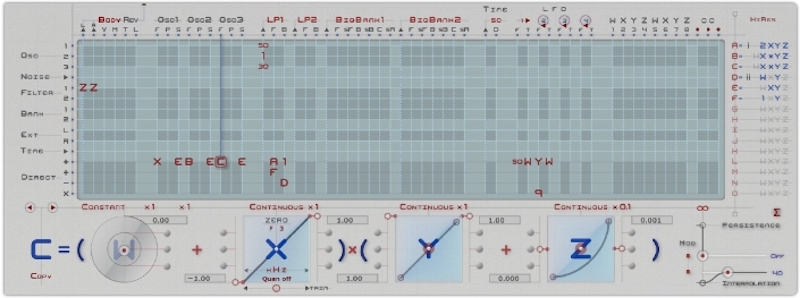
The mere mention of formulas might be enough to make some musicians run away in fear, but great EaganMatrix patches don't necessarily need to be complicated. One simple example would be to control something like filter cutoff with pressure, so applying higher pressure then results in brighter timbres. But formulas can also process EaganMatrix's internal control sources, or external pedals connected to Osmose, thus it is easily possible to make complex relationships based upon how you are playing the instrument at any given moment. Introduce secondary layers with certain gestures, or intuitively create variation from note-to-note by intentionally considering your attack contours.
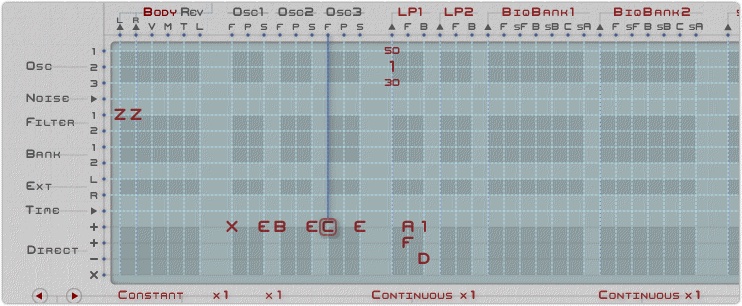 A portion of the EaganMatrix, as seen for the Haken Continuum Editor
A portion of the EaganMatrix, as seen for the Haken Continuum Editor
EaganMatrix also transcends well beyond traditional synthesizer archetypes, and incorporates many different methods of synthesis. While classic subtractive and FM sounds may be easily found—and enhanced with Osmose's performative gestures—there are also several other techniques that are uncommon for a polyphonic keyboard instrument. Through remarkable implementations of granular synthesis, physical modeling, and the incorporation of waveguides and convolution, there's no shortage of profound ways to interact with a patch.
Due to the naturally complex capabilities of EaganMatrix, even seasoned synthesis and sound design veterans might feel intimidated by the prospect of crafting their own patches. But Expressive E has invested substantial effort into the factory sound presets on Osmose, and with the degree of expression that this instrument is capable of there's almost certainly enough to keep you satisfied for awhile.
An interesting note is that because Osmose and Continuum Fingerboard share the same sound engine but are fundamentally such different designs, playing an identical EaganMatrix patch on one instrument or the other would yield very different results. Haken Audio brings up great analogies on their EaganMatrix page, comparing the Continuum to instruments like violin, trumpet, and theremin while Osmose is likened to piano. These comparisons may seem obvious, but it's a helpful reminder in contexualizing how sounds will differ between the two. Osmose handles discrete pitch "rounding" to each key and thus can feel very "fast" to play accurately, whereas the Continuum requires attention to intonation and inflection to every single note, just as would be necessary on any of the instruments listed above.
The entire point of Osmose, and MPE controllers and instruments as a whole, is simply to give electronic musicians more freedom of expression from the moment they press a key. There's less reliance on automation and control signals, and an embrace of the human-element of musical performance. Osmose is truly a player's instrument, but virtuosity is absolutely not a prerequisite to get a lot out of it. Simply experiencing its incredible coupling of movement and sound will inspire you to play Osmose in ways you'd never consider—and even to play things you might not have believed you were capable of.
It was a long journey to bring Osmose into the world, and we're glad the Expressive E stuck it out to the end. Most of all, we're eager to hear music made with Osmose and see how the future of MPE and expressive synthesizers and controllers is shaped by this instrument's availability.

